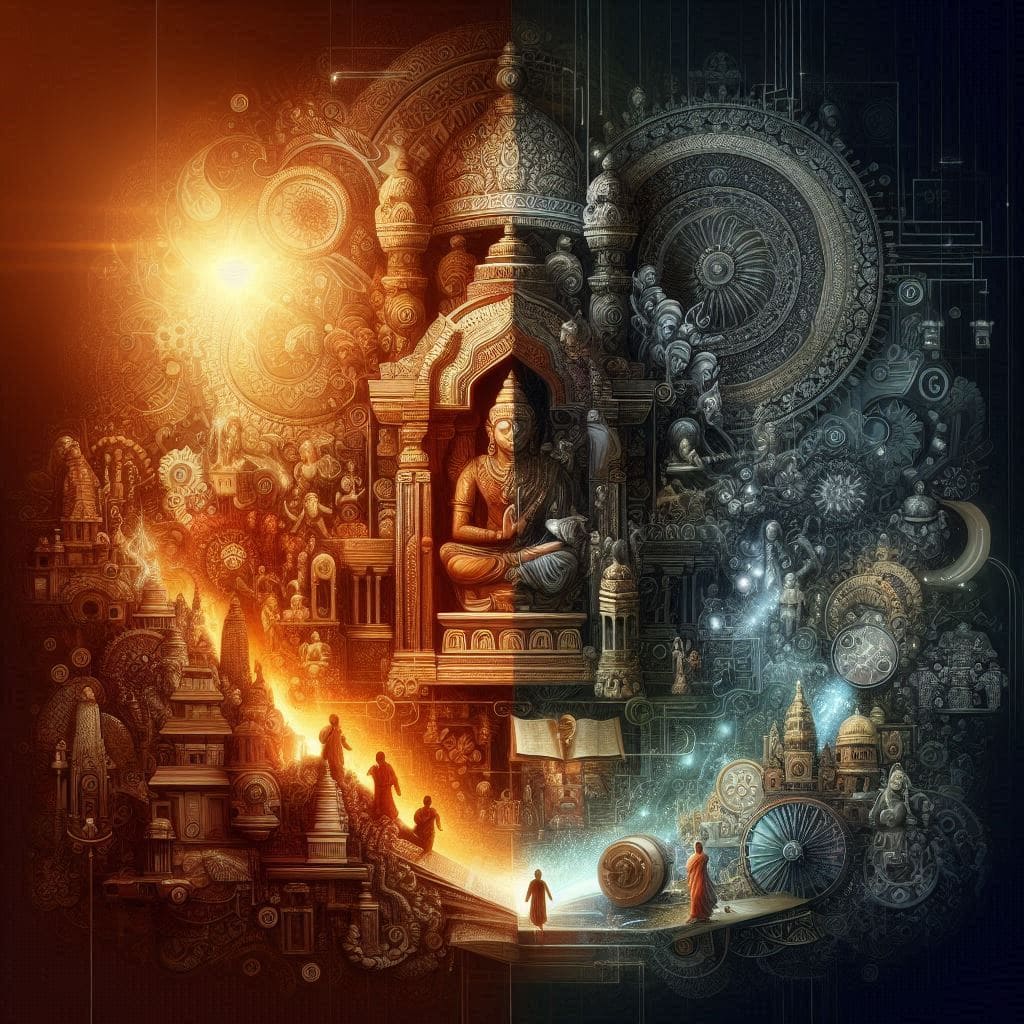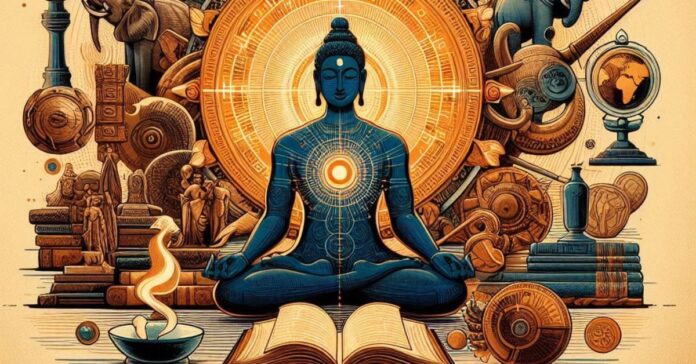Hinduism stands as one of the most ancient and multifaceted religions in the world, with a vast and intricate tapestry of rituals, diverse philosophies, and sacred texts that date back thousands of years. Its deep roots provide a unique and profound understanding of human spirituality in ancient societies, shedding light on the evolution of religious beliefs and practices across millennia. Exploring the vast historical landscape of Hinduism not only enriches our comprehension of the past, but also fosters a profound appreciation for its enduring and far-reaching impact on art, literature, philosophy, and social structures throughout history.

Origins of Hinduism
Determining the exact age of Hinduism poses significant challenges due to its gradual development over thousands of years. Unlike religions with a single identifiable founder, Hinduism has evolved from a rich tapestry of cultural and spiritual traditions originating in ancient India. This complex and gradual evolution makes it difficult to pinpoint a specific moment of inception for the religion.
Early Signs and Historical Context
The origins of Hinduism can be traced back to prehistoric times in the Indian subcontinent. The religion’s development is believed to have been influenced by the practices and beliefs of the early inhabitants of the region. The elements of Hinduism, such as the worship of deities and reverence for nature, were present in the rituals and traditions of these early communities. These foundational elements continued to evolve over time and eventually formed the rich tapestry of beliefs and practices that characterize Hinduism today.
Ancient Civilizations and Cultural Influences
The roots of Hinduism can be traced back to the rich cultures of ancient Indian civilizations. The Indus Valley Civilization, which thrived from around 3300 BCE to 1300 BCE, has provided some of the earliest archaeological evidence of religious practices that are believed to have laid the foundation for what later became associated with Hinduism. This evidence includes artifacts, symbols, and structures that suggest the existence of complex religious rituals and beliefs, giving us valuable insights into the early religious practices of the region.
The Vedic Period
The Significance of the Vedas
The Vedas, written in Sanskrit, are a collection of ancient religious texts that hold immense significance in Hinduism. These texts are considered to be among the oldest sacred scriptures in the world and are revered as the foundation of Hindu religious knowledge. The Vedas consist of hymns, prayers, and rituals dedicated to various deities, offering a comprehensive insight into the spiritual and cultural practices of ancient India. These texts serve as not only a religious guide but also as a valuable source of historical and philosophical wisdom, providing deep and profound insights into the beliefs and practices of early Hindu society.
Timeline of the Vedic Period
The Vedic Period, which lasted from approximately 1500 to 500 BCE, is a significant phase in Hindu history. It was during this era that the core texts of Hinduism, such as the Rigveda, were composed. These texts not only provided a foundation for the practice and philosophy of Hinduism but also played a crucial role in shaping the religious and societal landscape of ancient India. The Vedic Period represents a time of profound intellectual and spiritual exploration, laying the groundwork for the rich and diverse tapestry of beliefs and traditions that continue to characterize Hinduism today.
Hinduism in the Indus Valley Civilization
Archaeological Evidence
Artifacts from the Indus Valley Civilization, such as seals depicting deities and ritual baths, suggest the presence of early religious practices. These findings indicate a continuity between ancient practices and later Hindu traditions.
Cultural and Religious Practices
The religious life of the Indus Valley people likely included rituals that evolved into Hindu ceremonies. The emphasis on purity, as seen in the Great Bath of Mohenjo-daro, resonates with later Hindu practices.
Development of Major Texts
Upanishads
The Upanishads, written between 800–400 BCE, are philosophical texts that explore the nature of reality and the self. They mark a shift from ritualistic practices to spiritual introspection and are central to Hindu thought.
Mahabharata and Ramayana
The Mahabharata and Ramayana, epic narratives composed around the 4th century BCE to 2nd century CE, are crucial to Hindu culture. These epics encapsulate moral dilemmas, heroic tales, and spiritual teachings that continue to influence Hinduism today.
Evolution Through the Ages
Post-Vedic Developments
Following the Vedic Period, Hinduism saw the emergence of various schools of thought, sects, and traditions. This era was marked by the codification of laws and practices in texts like the Manusmriti.
Classical Period of Hinduism
The Classical Period (c. 200 BCE–1200 CE) witnessed the growth of devotional movements and temple construction. It was during this time that major Hindu deities such as Vishnu, Shiva, and Devi became prominent.
Spread and Influence
Geographic Spread
Hinduism’s influence extended beyond India to Southeast Asia through trade and cultural exchanges. Temples and inscriptions found in countries like Indonesia and Cambodia reflect its widespread impact.
Influence on Other Religions and Cultures
Hinduism has significantly influenced other religious traditions, including Buddhism, Jainism, and Sikhism. Concepts like karma and dharma, originating in Hinduism, have permeated various cultural and religious contexts worldwide.
Hinduism in the Medieval Period
Changes and Continuity
The medieval period saw both continuity and change within Hinduism. The Bhakti movement, which emphasized personal devotion to a deity, brought about a renewed focus on devotional practices.
Bhakti Movement
The Bhakti movement (c. 7th to 17th century CE) was a major devotional trend that sought to transcend caste distinctions and promote a personal relationship with God. Saints like Kabir and Mirabai became iconic figures during this period.
Hinduism in the Modern Era
Colonial Impact
The arrival of European colonizers in India brought about significant changes. While Hinduism faced challenges, such as missionary efforts and colonial policies, it also experienced a period of revival and reform.
Revival and Reform Movements
Figures like Swami Vivekananda and Mahatma Gandhi played pivotal roles in the Hindu renaissance, emphasizing spiritual and social reforms. These movements aimed to adapt Hinduism to the modern world while preserving its core values.
Hinduism Today
Contemporary Practices
Hinduism, one of the world’s oldest religions, has transformed into a global phenomenon with diverse practices. In India, elaborate temple rituals form an integral part of the religious experience. These rituals, which vary by region, involve intricate ceremonies and offerings to the deities. On the other hand, outside of India, in Western countries and beyond, yoga and meditation sessions have become synonymous with Hindu spiritual practices. These activities, recognized for their calming and introspective qualities, present a different facet of the tradition. Despite geographical and cultural differences, Hindu traditions continue to evolve and thrive, adapting to new contexts and appealing to a growing global audience.
Global Presence
The Indian diaspora, through their migration and settlement in various countries, has played a significant role in spreading Hinduism across the globe. This has resulted in the establishment of Hindu temples, the celebration of Hindu festivals, and the formation of cultural organizations in different continents. These efforts have contributed to the sustenance and promotion of Hinduism, ensuring that it remains vibrant and pertinent in the modern world.
Debates on the Age of Hinduism
Scholarly Perspectives
Scholars debate the exact age of Hinduism, with estimates ranging from 4,000 to over 6,000 years old. This variance is due to the complex nature of its origins and development over time.
Controversies and Challenges
Pinpointing the precise age of Hinduism is challenging due to the lack of definitive historical records. The reliance on oral traditions and the blending of cultural influences add to the complexity.
Scientific and Archaeological Insights
Recent Discoveries
Recent archaeological discoveries continue to shed light on the ancient origins of Hinduism. Findings from sites like Rakhigarhi suggest an even earlier timeline for its development.
Technological Advances in Dating
Advancements in technology, such as radiocarbon dating and genetic studies, provide new methods for understanding the antiquity of Hindu practices and artifacts.
Cultural Significance of Hinduism’s Age
Identity and Heritage
For many Hindus, the age of their religion is a source of pride and identity. It connects them to a rich heritage that has withstood the test of time and remains a vital part of their cultural fabric.
Global Perception
The ancient origins of Hinduism contribute to its global perception as a profound and enduring tradition. Its timeless teachings continue to attract followers and scholars worldwide.
Conclusion
Understanding the age of Hinduism is crucial in gaining valuable insights into the history and spirituality of humanity. While it is a challenging task to pinpoint an exact timeline, the evidence suggests that Hinduism is one of the world’s oldest living religions, with roots stretching back thousands of years. The religion’s evolution over millennia showcases its adaptability and enduring relevance in a variety of cultural and historical contexts, making it an essential part of global spiritual heritage.








